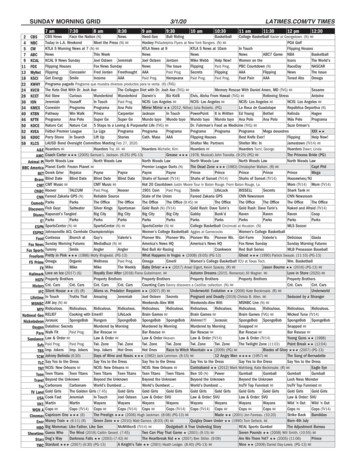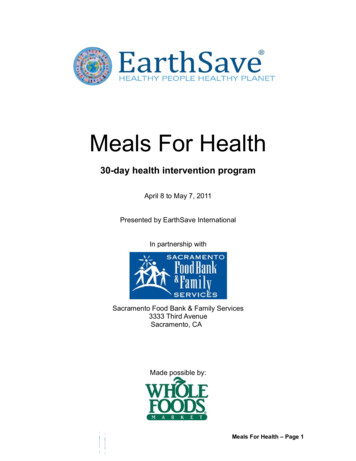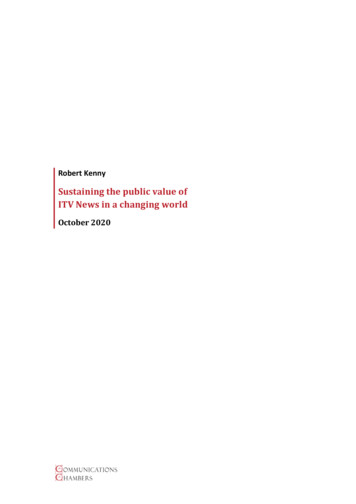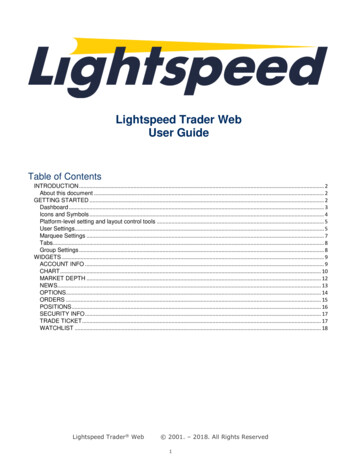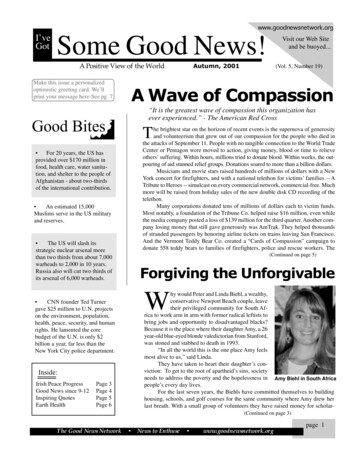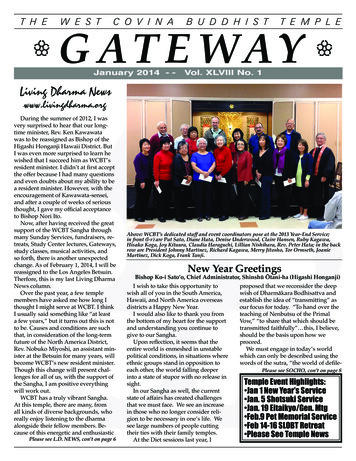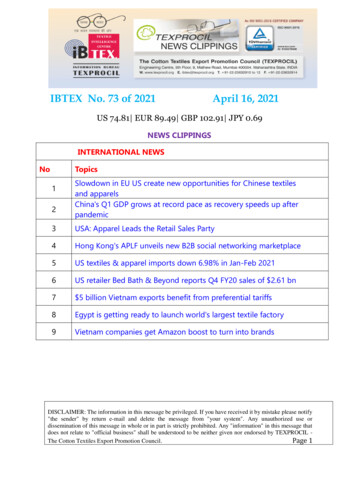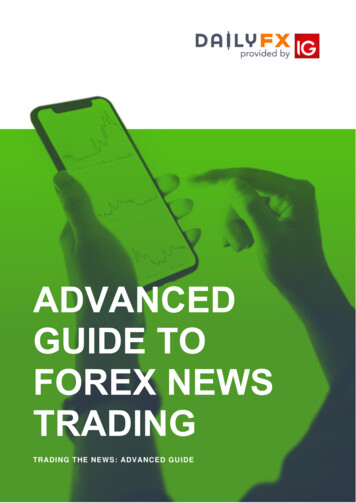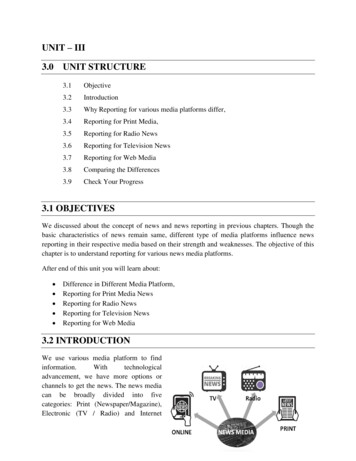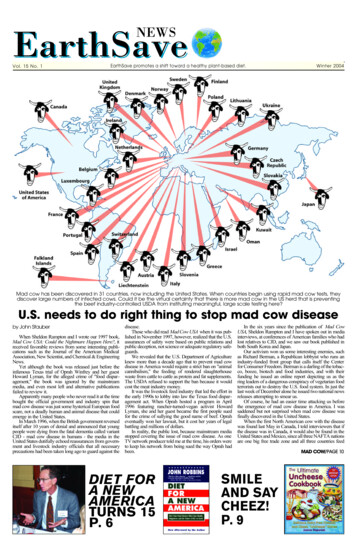
Transcription
EarthSaveNEWSVol. 15 No. 1EarthSave promotes a shift toward a healthy plant-based diet.Winter 2004Mad cow has been discovered in 31 countries, now including the United States. When countries begin using rapid mad cow tests, theydiscover large numbers of infected cows. Could it be the virtual certainty that there is more mad cow in the US herd that is preventingthe beef industry-controlled USDA from instituting meaningful, large scale testing here?U.S. needs to do right thing to stop mad cow diseaseby John StauberWhen Sheldon Rampton and I wrote our 1997 book,Mad Cow USA: Could the Nightmare Happen Here?, itreceived favorable reviews from some interesting publications such as the Journal of the American MedicalAssociation, New Scientist, and Chemical & EngineeringNews.Yet although the book was released just before theinfamous Texas trial of Oprah Winfrey and her guestHoward Lyman, for the alleged crime of "food disparagement," the book was ignored by the mainstreammedia, and even most left and alternative publicationsfailed to review it.Apparently many people who never read it at the timebought the official government and industry spin thatmad cow disease was just some hysterical European foodscare, not a deadly human and animal disease that couldemerge in the United States.In March 1996, when the British government reverseditself after 10 years of denial and announced that youngpeople were dying from the fatal dementia called variantCJD - mad cow disease in humans - the media in theUnited States dutifully echoed reassurances from government and livestock industry officials that all necessaryprecautions had been taken long ago to guard against thedisease.Those who did read Mad Cow USA when it was published in November 1997, however, realized that the U.S.assurances of safety were based on public relations andpublic deception, not science or adequate regulatory safeguards.We revealed that the U.S. Department of Agricultureknew more than a decade ago that to prevent mad cowdisease in America would require a strict ban on "animalcannibalism," the feeding of rendered slaughterhousewaste from cattle to cattle as protein and fat supplements.The USDA refused to support the ban because it wouldcost the meat industry money.It was the livestock feed industry that led the effort inthe early 1990s to lobby into law the Texas food disparagement act. When Oprah hosted a program in April1996 featuring rancher-turned-vegan activist HowardLyman, she and her guest became the first people suedfor the crime of sullying the good name of beef. Opraheventually won her lawsuit, but it cost her years of legalbattling and millions of dollars.In reality, the public lost, because mainstream mediastopped covering the issue of mad cow disease. As oneTV network producer told me at the time, his orders wereto keep his network from being sued the way Oprah hadbeen.DIET FORA NEWAMERICATURNS 15P. 6In the six years since the publication of Mad CowUSA, Sheldon Rampton and I have spoken out in mediainterviews, at conferences of American families who hadlost relatives to CJD, and we saw our book published inboth South Korea and Japan.Our activism won us some interesting enemies, suchas Richard Berman, a Republican lobbyist who runs anindustry-funded front group that calls itself the Centerfor Consumer Freedom. Berman is a darling of the tobacco, booze, biotech and food industries, and with theirfunding he issued an online report depicting us as thering leaders of a dangerous conspiracy of vegetarian foodterrorists out to destroy the U.S. food system. In just thelast week of December alone he issued two national newsreleases attempting to smear us.Of course, he had an easier time attacking us beforethe emergence of mad cow disease in America. I wassaddened but not surprised when mad cow disease wasfinally discovered in the United States.When the first North American cow with the diseasewas found last May in Canada, I told interviewers that ifthe disease was in Canada, it would also be found in theUnited States and Mexico, since all three NAFTA nationsare one big free trade zone and all three countries feedSMILEAND SAYCHEEZ!P. 9MAD COW/PAGE 10
Perspectives2 Winter 2004A word from the ChairHappy New World2003 ended with a bang when mad cow disease was discovered inWashington state. This Winter issue of EarthSave News we present anumber of interesting perspectives on the subject, including an articlefrom Michael Greger, MD looking at a controversy now gainingincreasing attention -- whether a US version of mad cow disease hasalready been here for years, perhaps killing thousands annually (seepage 5).EarthSave’s prescient Test Cows Now initiative has taken someimportant steps forward. In April of last year, John Robbins presented Presidential hopeful Dennis Kucinich (D-OH) with thousands ofsignatures collected by EarthSave from people demanding more madcow testing. Rep. Kucinich has responded with a promise (along withRep. George Miller (D-CA)) to introduce legislation which wouldmandate increased testing for mad cow (see page 5).You might ask, why is an organization which promotes a shift awayfrom a meat-based diet and toward plant-based eating interested intesting cattle for mad cow? Because if there is widespread mad cowin the US herd -- as many experts believe -- this is a fact consumershave a right to know so that they can make informed choices abouttheir diets. And making diet choices based on accurate and honestinformation is what EarthSave promotes.The past Fall also saw a celebration of the 15th anniversary of thepublication of Diet for a New America. This is, of course, the seminalwork that brought EarthSave International into existence. Its author - our founder, John Robbins -continues to inspire people tolive healthier, saner and morecompassionate lives. He and hiswork were honored in Octoberat an event at Roxanne's, a fabulous gourmet raw foods restaurant in Larkspur, CA (see pages6 and 7).We have been heartened bythe outpouring of positive comments in response to last issue'sarticleonrestructuringEarthSave, and have selected afew to print in the Letters secJohn Borders and family.tion, below. Thanks so much foryour support in this transition. And please consider using the form atthe bottom of page 12 to make a donation to help EarthSave continueour critical work. Our planet and our health are depending on it.Yours for a happy, healthy and well-informed New Year,John D. Borders, Jr., JDCHAIR, EARTHSAVE BOARD OF DIRECTORSLeft-wing crapWhile reading last issue's mainarticle about, among other things,Earthsave's mission, I was disappointed to see an article on theback page about the Iraq campaignand Fox news.Like the fool who can't eat ameal without including meat, youcan't run an enterprise devoted tovegetarianism without adding yourleft-wing crap.David SklarChicago, ILThe Editor responds: Part ofthe reason EarthSave exists isbecause there is so much distortionand dishonesty in the media. Thefact is, what people are exposed today in and day out relating to dietis not what’s best for their individual health or the health of the planet, but what is primarily best forthe meat, dairy and food indus tries. Does Fox News run freePublic Service Announcementsattacking PETA because they arelooking after the welfare of theAmerican public? No, they are andhave been providing free air timeto attack a vegetarian non-profitbecause Fox’s bread is buttered byEarthSave NewsIs this cow mad?by Jeffrey Moussaieff MassonHow many diseased cows are we missing?Humans ate the Washington cow's muscle, and itsCharles Darwin once famously asked what a cow spinal cord became food for pigs and poultry, whichthinks about when she looks at a dying companion. we in turn eat. Is this risking human health? Are thereThe answer has evaded humans for centuries, other cows, as yet untested, harboring the disease? Ofbecause we have not generally cared what cows think course, or as my daughter used to say when she wasabout their lives, let alone their deaths. Research, a teenager: "Duuhh, Dad!"however, indicates that cows have enormous, comCan anything good come of all this? Yes. We canplex, folded brains, not so unlike those of humans. re-examine how we treat these deeply feeling aniWhat do they use such large brains for? To relate to mals. In the 1990s outbreak in Britain of BSE, 143one another, to keep track of family relations, just as people died, and millions of cattle were slaughtered.we do. Any farmer can tell you about the long moans But cattle are slaughtered every day in the U.S., to the(they sound like "moo") that a cow gives forth when tune of 35 million a year, not because they are sick,her calf is taken away from but because we want to eat them. Somehow, fiveher routinely a few hours thousand years ago, we began to believe that it wasafter birth. Her mental our God-given right to slaughter any living creatureanguish is probably not so for food. It is time, for our sake, if not the sake of thedifferent from the anguish of animal, to pause and reconsider.a mother who loses her childSalmonella, E. coli, Campylobacter, cloggedat birth.arteries, bovine spongiform encephalopathy, corpoWe actually know quite a rate greed, political inertia, human arrogance, thebit about the emotional lives words pile up, and panic begins to seep into our lives.of cows and what they want. The solution is so simple. Humans are in fact far betJeffrey MassonWe know that cows want to ter off when we avoid animal products; we do notbe with each other. We also know what they want to need to eat meat. My wife is a pediatrician, andeat: grass. They evolved to eat it. And we especially before we married I asked her what was the singleknow what they don't want to eat: each other or any best thing I could do for my health and the health ofform of meat. They are obligate vegetarians. When our as-yet unborn children. Her answer? "Let's eat awe feed cows ground up carcasses, chicken excre- healthy diet free of animal products." And we did. Itment, and blood from other cows (a common and used to be considered a "fringe diet" for people to eatlegal practice in the U.S.), we are opening up the this way, suitable for fanatics and cultists. And yetfloodgates to diseases like BSE (bovine spongiform when heads of major corporations like Michaelencephalopathy, or mad cow disease, the one that Eisner of Disney and Steve Jobs of Apple and worldwastes their brains and ours), that will affect not only class athletes like Carl Lewis and Edwin Moses allcows, but also us.eschew animal products, you know it's made its wayHave we caused this disaster? Of course. Think into the mainstream.about "downer" -- that horrible but evocative word toIs this a solution to the present problem? You bet.indicate a cow too sick to walk. How many are there? Is it likely to be followed? Yes, it is, by ordinary peoThe Agricultural Department estimates that in 1999 ple who care about animals, who care about thethere were at least 195,000. (If we use the more strin- health of our planet, and who care about how longgent definition of "downer" used by Europe and the and how well they are going to live.rest of the world, the figure is closer to 700,000 annually in the U.S.) Of these, all through the 1990s, onlyJeffrey Moussaieff Masson is the author of Thea few hundred were ever tested. (In Canada the one Pig Who Sang to the Moon: The Emotional World ofdiseased cow was tested only because it was thin.)Farm Animals. Visit http://jeffreymasson.comLettersthe food-industrial complex. It’simportant and useful to theEarthSave cause to help peoplerealize they cannot believe whatthey hear and see, and that certainoutlets have certain agendas,which agendas are at odds withtruth. It is neither “left-wing” or“right-wing” to point out liars, butit is part of how EarthSave does itsjob.Hooray for restructuring!The enclosed check is not arenewal. It is an additional yearend donation. It is important to methat the people at EarthSave knowwhy I am choosing to do this.When I first heard of you a fewyears ago, what most prompted meto become a member was yournon-judgmental approach and yourattempt to encourage a shift towarda plant-based diet. While I myselfam vegan, not everyone is ready orwill ever be ready for that. Andwhile I may agree with the goals ofanimal rights groups, some of theirmethods go against my values andtherefore I do not give them financial cupport. Sometimes I thinktheir approach turns more peopleagainst vegetarianism than it converts.I just wanted you to know thatthis member, anyway, supportsyour position to change. I thinkthere is a very real need for yourgroup, and because of your friendly, welcoming, non-judgementalattitude that does not exclude anyone, you are the one group I plan tosupport in the future. Thanks forall your hard work.Julia AmbroseElgin, ILWe totally agree with yourdecision to retain most of the yearly membership fees!Using the Sierra Club andHabitat for Humanity as ideasources is another positive concept.You are not abandoning thelocal chapters with this decision.You can be more effective usingthe fees to sustain and in ' buildingmembership', there is strength innumbers, especially if they areactive; thus making for a healthierdynamic organization.Another facet: EarthSave mustbe inclusive. My wife is “still”, onoccasions a meat eater, she hasprogressed slowly and in the main,is a vegetarian, with an urge oncein awhile for her ribs. We all comethe vegetarianism at our own pace.Being judgmental or critical ofothers does not serve to further“our way.”Also agree with your restructing and emphasis using to theMission Statement which was usedover many previous years.We also belong to numerousanimal rights organizations andwork with them in their particularcauses. Where they merge or areparallel with EarthSave within acommunity . . . that is a plus!We feel EarthSave is on theright track, and feel very excitedwith the energies expressed in yourcover article (and the whole issuefor that matter!). Go do it!Personally, we haven’t beenmore enthused and hopeful aboutEarthSave as we are now.Namaste,Lauren & Ginger BrightwellBellingham, WALet me commend you on thethe honest, thorough and importantcover article in your Fall '03newsletter. I got confusing information from my local chapterabout what was going on, and(seemingly) no information fromnational headquarters, so I haddecided to discontinue myEarthSave membership. I was notinterested in supporting an organization with internal divisions,staffed by people moved by thesame intentions, but unable towork together. Your article turnedme around. I appreciated your willingness to expose mistakes, andthen move forward after correctingthem.Also, I didn't understand whyEarthSave decided to change itsmission several years ago. I nowwant to say that I believe this organization is back on track.Name withheld by requestThink About It."In a world where an estimated one in every six people goes hungry every day, the politics of meat consumption are increasingly heated, since meat production isan inefficient use of grain -- the grain is used more efficiently when consumed directly by humans. Continued growth in meat output is dependent on feedinggrains to animals, creating competition for grain between affluent meat eaters and the world's poor."-Worldwatch Institute“The impact of countless hooves and mouths over the years has done more to alter the type of vegetation and land forms of the West than all the water projects,strip mines, power plants, freeways, and subdivision development combined."- Philip Fradkin, in Audubon magazine"Although cattle grazing in the West has polluted more water, eroded more topsoil, killed more fish, displaced more wildlife, and destroyed more vegetation thanany other land use, the American public pays ranchers to do it!"-Ted Williams, environmental author"The contamination of the nations' waterways from [pork] manure run-off is extremely serious. Twenty tons of [pork and other] livestock manure are produced forevery household in the country. We have strict laws governing the disposal of human waste, but the regulations are lax, or often nonexistent, for animal waste."- Union of Concerned ScientistsRead John Robbins’ The Food Revolution for these and many other important facts about the impact of diet choices on the environment, our health,and all life on earth.
EarthSave NewsScience NewsStudy: More TV means fewerveggies for teensThe more television children watch the less fruitand vegetables they eat, probablybecause the advertising they seeleaves them craving junk foodinstead, according to a Harvardstudy published in December of2003.Children surveyed for the studywho spent more time watchingtelevision ate 0.16 fewer servingsof fruit and vegetables for everyextra hour watched. That additional hour a day of TV watchingadded up to one less nutritionalserving every six days.Heavy television viewing by children has beenlinked to eating more junk food, getting less exercise and obesity, but this was the first study to showthat TV watching led to lower consumption of nutritious fruit and vegetables, said the report, which waspublished in the journal Pediatrics.At the start of the survey in 1995, the children,who averaged 12 years of age, ate an average of 4.23servings of fruit and vegetables per day, which wasbelow the government-recommended five daily servings.The rising epidemic of childhood obesity in the United Statesand other industrialized nationshas been linked to cardiovasculardisease in even young children,and to an accumulation of healthproblems later in life.American children spend moretime watching television thanengaging in any other activityexcept sleeping, averaging 22hours of viewing a week, thereport said. They are exposed to 20,000 TV commercials a year, or 150 to 200 hours worth.Study author Renee Boynton-Jarrett of theHarvard School of Public Health said most foodadvertising aired during children's shows conflictwith healthy eating habits."Little of this marketing is aimed at fruit andvegetables," the report said.Eat your onions to protectagainst prostate cancerA new analysis of prostate cancer rates in different countries suggests that vegetables, includingonions, can help reduce the risk of prostate cancer.Previous work has suggested that lycopene, thesubstance that makes tomatoes red, can protectagainst prostate cancer. But this isn't found in a newstudy from independent health researcher William B.Grant, who is based in Virginia, USA. Starting fromdata on prostate cancer rates in different countries, hefound no protective effect from lycopene. Prostatecancer mortality rates in the US and Northern Europeare about five times more than they are in HongKong, Iran, Japan and Turkey. According to Dr. Grant,animal products such as dairy and meat are thestrongest risk factors for prostate cancer. And vegetables, especially onions, cereals and beans were riskreduction factors. The findings re-emphasize theimportance of including plenty of fresh produce inyour daily diet, and avoiding or reducing meat anddairy products.Source: European Urology 22nd December 2003Human evolution can't cope with fastfood, say scientistsCalorie-packed fast food encourages over-eatingand weight gain because it is out of step with humanevolution, scientists have said.They pointed out that humans are designed forconditions in which food is relatively scarce and lowin energy.But fast food from take-aways and conveniencestores is typically energy dense. You do not need toeat much of it to consume a lot of calories.The result is people accidentally over-eat withoutfeeling particularly full.Nutrition experts Professor Andrew Prentice andDr. Susan Jebb highlighted the problem by combiningBritish and African diet study data with informationon the ingredients in fast food.Professor Prentice, head of the Medical ResearchCouncil's International Nutrition Group at theLondon School of Hygiene and Tropical Medicine,said: "We all possess a weak innate ability to recognise foods with a high energy density. We tend toassess food intake by the size of the portion, yet a fastfood meal contains many more calories than a similar-sized portion of a healthy meal."Since the dawn of agriculture, the systems regulating human appetite have evolved for the low energy diet still being consumed in rural areas of thedeveloping world where obesity is almost non-existent."Our bodies were never designed to cope with thevery energy dense foods consumed in the West andthis is contributing to a major rise in obesity."The World Health Organisation estimates thereare 300 million obese people worldwide.Winter 2004 3U.S. teens are fattestTeenagers in the United Stateshave higher rates of obesity thanthose in 14 other industrializedcountries, including France andGermany, a study of nearly 30,000youngsters ages 13 and 15 found.Among American 15-year-olds, 15percent of girls and nearly 14 percent of boys were obese, and 31percent of girls and 28 percent ofboys were more modestly overweight.The findings are based onschool questionnaires given toyoungsters in the 15 countries in1997 and 1998. The study was ledby Inge Lissau, a researcher at theNational Institute of Public Healthin Copenhagen, Denmark, and waspublished in the January issue ofArchives of Pediatrics &Adolescent Medicine.U.S. teens were more likelythan those in other countries to eatfast food, snacks and sugary sodasand were more likely to be drivento school and other activities, contributing to a more sedentarylifestyle, said co-author MaryOverpeck of the U.S. Maternal andChild Health Bureau."The rest of the world may becatching up, but we're still in firstplace in a race that unfortunatelywe shouldn't want to be winning,"said Dr. David Ludwig, an obesityresearcher at Children's HospitalBoston who was not involved inthe study. He led a study publishedMonday in another journal,Pediatrics , that found that nearlyone-third of U.S. youngsters eatfast food on any given day.Lithuania had the lowest obesity rates in the latest study. AmongLithuanian 15-year-olds, about 2percent of girls and 0.8 percent ofboys were obese, and 8 percent ofgirls and 5 percent of boys wereoverweight.That is probably becauseLithuania has fewer fast-foodrestaurants and its teens have lessmoney to buy snacks and fastfood, Overpeck said.Doctors groupseeks to eliminatesodas in schoolsSoft drinks should be eliminated from schools to help tackle thenation's obesity epidemic andpediatricians should work withtheir local schools to ensure thatchildren are offered healthfulalternatives,theAmericanAcademy of Pediatrics said inJanuary.In a new policy statement, theacademy says doctors should contact superintendents and schoolboard members and "emphasizethe notion that every school inevery district shares a responsibility for the nutritional health of itsstudents."Some schools already limitcontracts with vendors of softdrinks and fast foods, though thesoft drink industry has foughtefforts by some states to mandatesuch restrictions.While some schools rely onfunds from vending machines topay for student activities, the newpolicy says elementary and highschools should avoid such contracts, and that those with existingcontracts should impose restrictions to avoid promoting overconsumption by kids.The policy appears in theJanuary issue of Pediatrics. "Thepurpose of the statement is to giveparents and superintendents andschool board members and teachers, too, an awareness of the factthat they're playing a role in thecurrent obesity crisis, and thatthey have measures at their disposal" to address it, said Dr.Robert D. Murray, the policy'slead author.Soft drinks are a commonsource of excess calories that cancontribute to weight gain. Softdrink consumers at all ages have ahigher daily calorie intake thannonconsumers, the academy's policy said. It cites data showing that56 percent to 85 percent ofschool-age children consume atleast one soft drink daily.Beef industry develops beef-basedsnack food called cheeseburger friesAt 4 grams of fat per fry, they just may kill off their customers!If the National Cattlemen's Beef Association hasits way, beef won't be just for dinner anymore.Looking to emulate the success of ChickenMcNuggets andfried mozzarella sticks, thegroup is hopingto inject somered meat intothe Americansnack food dietwith cheeseburger fries.Thefries,which look likea squat versionofstandardfrench fries, aremade of a meatand cheese compound that tastes - as the name suggests - like a cheeseburger.Breaded, deep fried, and served with ketchup orbarbecue sauce, cheeseburger fries have found theirway onto menus in several states, including Nebraska,Minnesota and Texas, since June. There is also a version being made available to public school cafeterias."The challenge is getting people to think ofother ways to eat beef,"said Betty Hogan, director of new product marketing for the association.Like most bar snacks,cheeseburger fries packquite a dietary wallop.Each individual fry hasabout 75 calories and 4grams of fat. The fries forschools have less beef perserving but still haveabout 60 calories and, infact, more fat - a total of 6grams - in each fry. And nobody eats just one.The National Cattlemen's Beef Association couldn't be happier. "We want beef in dessert if we can getit there," Hogan said.What does a healthy plantbased diet look like? It would include lots of freshvegetables and fruits.? It would be low in refinedand processed foods and sugar.? It would not include hydrogenated fats and trans-fats (foundin many margarines and whiteflour pastries).? It would be low in both saturated animal fats and vegetableoils such as safflower, corn, sunflower, and cottonseed oils.? It would include more waterand less soda pop, more bakedpotatoes and fewer French fries,and more whole grains and fewerproducts made from refined flour.(The American Institute forCancer Research says 40 studieshave linked regular consumptionof whole grains with a 10 to 50percent lower risk of certain cancers).? When possible, it would feature locally and organically grownfoods.? It would not include msg,artificial preservatives, colors, orother chemical additives.
Food and Medicine4 Winter 2004EarthSave NewsNEWS Macular Degeneration: BlindEarthSaveOur MissionEarthSave educates peopleabout the powerful effects ourfood choices have on theenvironment, our health and alllife on Earth, and encourages ashift toward a healthy,plant-based diet.Board of DirectorsJOHN ROBBINSFOUNDER, BOARD CHAIR E MERITUSJOHN D. BORDERS, JR., J.D.CHAIRJEFF NELSONVICE-C HAIRCARYN HARTGLASSSECRETARYMARK E PSTEINT REASURERJULES OAKLANDER, D.O.ANIL SUBRAMANISANDY LAURIELegal AdvisorM ORGAN WARDSTITES &HARBISON LOUISVILLE, KYExecutive DirectorCARYN HARTGLASSNewsletter ContributorsD AN B ALOGH,JOHN D.BORDERS,JR.,J.D., JOELF UHRMAN MD, MICHAEL G REGER MD, JEFFREYM ASSON, JOHN M CD OUGALL MD, JEFFN ELSON, SABRINA N ELSON, JOHN STAUBER.Editorial BoardJOHN BORDERS, JEFF AND SABRINANELSON, CYNTHIA VOTHGraphic Design & ProductionGREG LEMIREMOVING? Please make sure theaddress on your mailing label iscurrent. Please contact us withupdates.MEMBERSHIP DATEPlease check your membershipdate on your address label -- itmay be time to renew! EarthSaveMagazine is published quarterlybyEarthSave InternationalPO Box 96New York, NY 10108Tel: 800-362-3648Fax: 718-228-2491information@earthsave.orgMore than 35 chapters andbranches -see page 12EarthSave News is distributed as amembership benefit to EarthSavemembers. Basic annual member ship in is 35 (tax-deductible).COMMENTS/SUGGESTIONSWe welcome your feedback andideas. Please write or email us.ContributorsThe deadline for articles, lettersand photos for the next issue isMarch 30, 2004, for considerationin the next issue. Fax, mail, or email submissions to the Editor at theoffice, or toinformation@earthsave.org.The editor reserves the right toreject or edit all submissions.Opinions expressed by contributorsare not necessarily those ofEarthSave International.EarthSave educates, inspires andempowers people to shift towarda diet centered on fruits, vegetables, grains and legumes -- foodchoices that are healthy for people and for the planet. Our influence and effectiveness is dependent upon our members, donors,and benefactors. 2004 EarthSave InternationalImage copyrights held by theartists.from the Western Dietby John McDougall, M.D.Like other degenerative diseases – heartdisease, stroke, arthritis – age-related maculardegeneration (AMD) is due primarily to ourdiet and secondarily to our lifestyle – thereforeeasily preventable, and to some extentreversible. This form of eye disease is the leading cause of blindness in people age 64 or olderliving in Western countries. The severe formwith impairment of vision affects 1.7 millionpeople in the United States, with 200,000 newcases annually. Characteristically, this is a disease of progressive, painless, loss of the centralvision in the macula of both eyes simultaneously. The macula is the part of the retina whichprovides our most acute and detailed vision,and is used for visual activities, like reading,driving, recognizing faces, watching television,and other fine work.Multiple studies clearly show that the samerisk factors that predict the development andprogression of coronary artery disease (heartdisease) also predict the chance of you losingyour eyesight from AMD:* Overweight people have more than twicethe risk of progression of this disease from themild form, which affects nearly 8 million people in the United States, to the severe blindingform over the next 5 years.1 Other common riskfactors shared by both diseases are cigarettesmoking, lack of exercise, high cholesterol, andhypertension.1* A diet high in all kinds of fats, includinganimal, trans-fats (margarines, shortenings),monounsaturated fats (olive oil), and other vegetable fats, increases the risk of developingAMD by two to three tim
Yet although the book was released just before the infamous Texas trial of Oprah Winfrey and her guest Howard Lyman, for the alleged crime of "food dispar-agement," the book was ignored by the mainstream media, and even most left and alternative publications failed to review it. Apparently many people who never read it at the time
